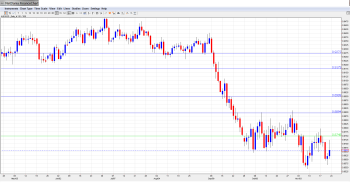AUD/USD headed to lower ground last week, losing close to 100 points. The pair closed at 0.8659. This week’s highlight is Private Capital Expenditure. Here is an outlook on the major market-movers and an updated technical analysis for AUD/USD.
An unexpected Chinese rate cut gave the Aussie a brief lift, but the currency still lost ground against the strong US dollar. In the US, the FOMC meeting minutes revealed little about the timing of a rate hike, but noted that the Fed is not overly concerned about weak growth in Japan and the Eurozone. Solid data from inflation, home sales and manufacturing helped the US dollar gain ground last week.
[do action=”autoupdate” tag=”AUDUSDUpdate”/]AUD/USD graph with support and resistance lines on it. Click to enlarge:
- RBA Deputy Governor Philip Lowe Speaks: Tuesday, 9:05. Lowe will deliver remarks at an event in Melbourne. The markets will be looking for clues as to the RBA’s future monetary policy, and any surprise comments from Lowe could affect the movement of AUD/USD.
- Construction Work Done: Wednesday, 00:30. This indicator is an important gauge of activity in the construction indicator. The indicator posted a decline of 1.2%, worse than the estimate of -0.4%. Another decline is expected in the upcoming reading, with an estimate of -1.7%.
- HIA New Home Sales: Thursday, Tentative. This housing indicator has shown volatility, and came in at a flat 0.0% in November following a strong gain in the previous release. This minor event is unlikely to have much impact on the movement of AUD/USD.
- Private Capital Expenditure: Thursday, 00:30. This is the key event of the week. This event is released every quarter, magnifying the impact of each release. The indicator posted a strong gain of 1.4% in Q2, after posting declines in the past two quarters. The markets are bracing for a decline in Q3, with an estimate of -1.7%.
- Private Sector Credit: Friday, 00:30. This is an important indicator since increased borrowing by the private sector usually translates into more spending, which is beneficial for the economy. The indicator has been steady in recent readings and posted a gain of 0.5% in October.
* All times are GMT.
AUD/USD Technical Analysis
AUD/USD started the week at 0.8751 and rose to a high of 0.8796. The pair then reversed directions, climbing all the way to 0.8566, as support at 0.8550 (discussed last week) held firm. AUD/USD closed the week at 0.8659.
Live chart of AUD/USD: [do action=”tradingviews” pair=”AUDUSD” interval=”60″/]
Technical lines from top to bottom:
We start with resistance at 0.9270. This line supported the pair in August but reverted to resistance in September with the Australian dollar sustaining steep losses.
0.9175 remains a strong resistance line. The round number of 0.9000 is next.
0.8898 continues to provide strong resistance.
0.8750 was breached last week and has reverted to a resistance role.
AUD/USD closed the week just below resistance at 0.8660. Look for this line to see action early in the week.
0.8550 faced pressure during the week but is currently a strong support level.
0.8316 marked the start low point of a US dollar rally in July 2010, which saw the greenback climb above the 1.10 level.
0.8150 is our final support line for now. It has remained intact since September 2007.
I remain bearish on AUD/USD.
US numbers were solid last week and the US economy continues to outperform that of Australia. Weak Chinese data continues to weigh on the Aussie, and the RBA minutes reiterated that the central bank considers the Aussie to be overvalued. So there is room for the currency to drop lower.
In our latest podcast, we talk about the state of US housing, run down the FOMC minutes, the Japanese jump, the Draghi drama and also talk oil:
Subscribe to our podcast on iTunes.
Further reading:
- For a broad view of all the week’s major events worldwide, read the USD outlook.
- For EUR/USD, check out the Euro to Dollar forecast.
- For GBP/USD (cable), look into the British Pound forecast.
- For the Australian dollar (Aussie), check out the AUD to USD forecast.
- For USD/CAD (loonie), check out the Canadian dollar forecast.
- For the kiwi, see the NZDUSD forecast.

